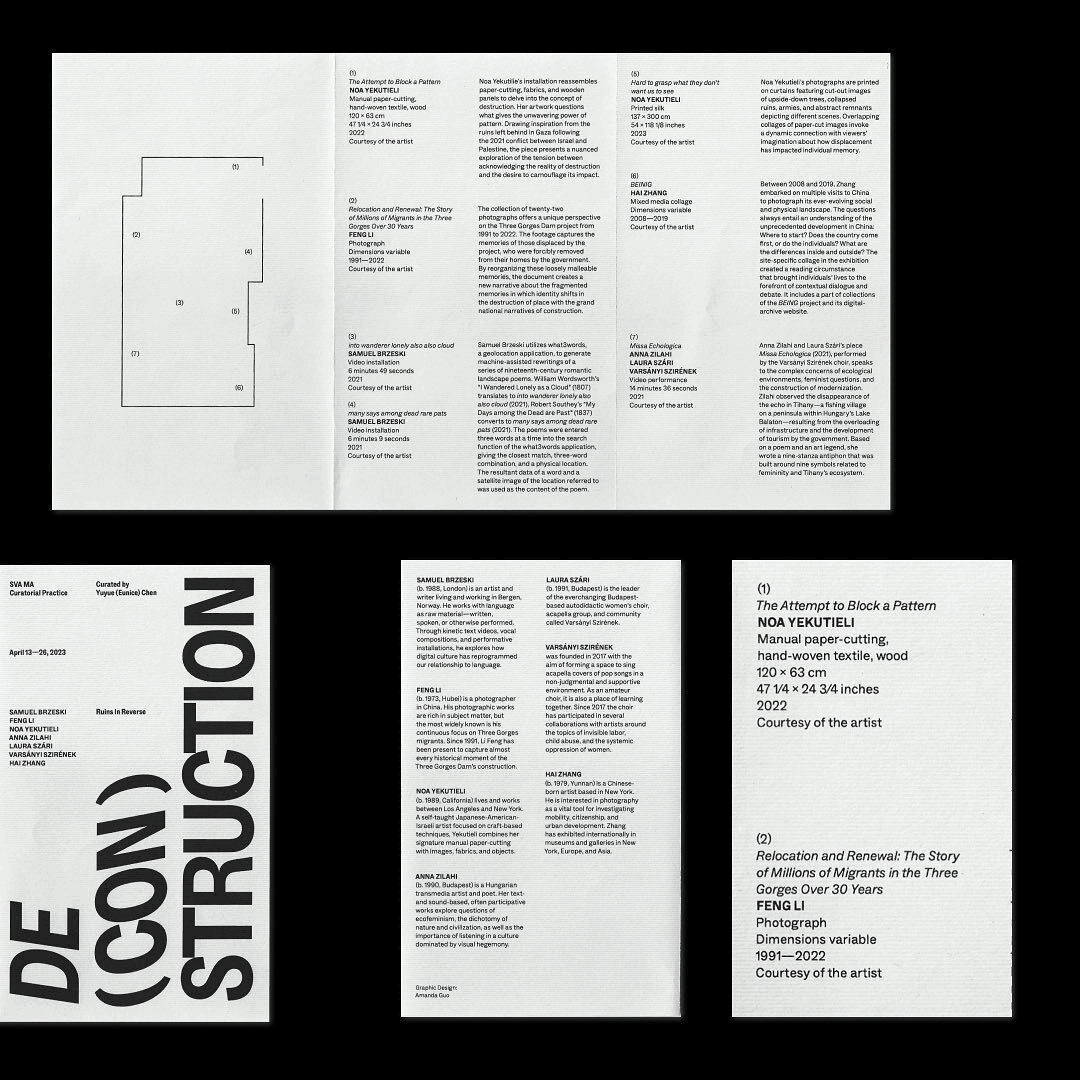DE(CON)STRUCTION: Ruins in Reverse
April 13 – April 26, 2023
On view Monday - Sunday, 11 am – 6 pm
Pfizer Building, 8th floor, 630 Flushing Avenue, Brooklyn, NY
Curated by Yuyue (Eunice) Chen
Artists: Samuel Brzeski, Feng Li, Noa Yekutieli, Anna Zilahi/Laura Szári/Varsányi Szirének, Hai Zhang
Graphic design: Amanda Guo

江河流水,潺湲不絕,後浪已不復為前浪。浮于凝滯之泡沫,忽而消佚,忽而碰撞,卻無長久飄搖之例。世人與栖息之處,不過如此。
——鴨長明《方丈記》
On flows the river ceaselessly, nor does its water ever stay the same. The bubbles that float upon its pools, now disappear, now form anew, but never endure long. And so it is with people in this world, and with their dwellings.
– Hōjōki: A Hermit’s Hut As Metaphor
De(con)struction: Ruins in Reverse draws on Robert Smithson’s term, “ruins in reverse,” to showcase the dynamic landscape that emerges from the process of destruction and construction. As Smithson wrote in “A Tour of the Monuments of Passaic, New Jersey”: “The buildings don’t fall into ruins after they are built but rather rise into ruin before they are built.” How do human beings, as a combination of animals, fantasists, and computers, experience and comprehend the ever-changing and fragmented nature of reality?
Artworks in De(con)struction: Ruins in Reverse employ evolving terrain as a means to deconstruct the fluidity of modernization in the context of rapid development and decay. Through photographs, archives, performances, poetry, and video, the artists propose the possibility of reshaping fluid and mobile fragments that will be reconstructed in developing landscapes. The exhibition exposes the complexity of modernization in border-making, abandonment, displacement, technological construction, and ecological destruction. It not only presents how the actual environment and ecology of the homelands of displaced people have been transformed on a massive scale but also seeks artworks and witnesses from artists and others around the world.
Feng Li and Hai Zhang’s extensive collections of photographs and notebooks, serving as archival materials, narrate individual experiences in their joint history and reflect the ever-evolving social and natural landscape in Chinese society along the Yangtze River from 1991 to 2022. Li’s collection of photographs documents the lives displaced by the Three Gorges Dam project from the lens of a documentary reporter; while Zhang’s project focuses on urban development, citizenship, and mobility from the perspective of an immigrant artist. In Noa Yekutieli’s installations, the Japanese-Israeli-American artist deconstructs the apparent pattern in the ruins by reassembling the fractured photographs, paper cuttings, and wood panels. The construction of modernization in Tihany, a village in Hungary, has disrupted its natural soundscape and caused echoes to disappear; thus, in response, Anna Zilahi and Laura Szári transpose poetry and artistic legends into choral music, reenacting the community’s collective rhythms in collaboration with the Varsányi Szirének choir. Samuel Brzeski works with the geolocation app what3words to rewrite a series of nineteenth-century romantic landscape poems into three-word phrases in juxtaposition with a new frame of the topographic satellite imagery.
Press release written by Yuyue (Eunice) Chen
Email for catalog











